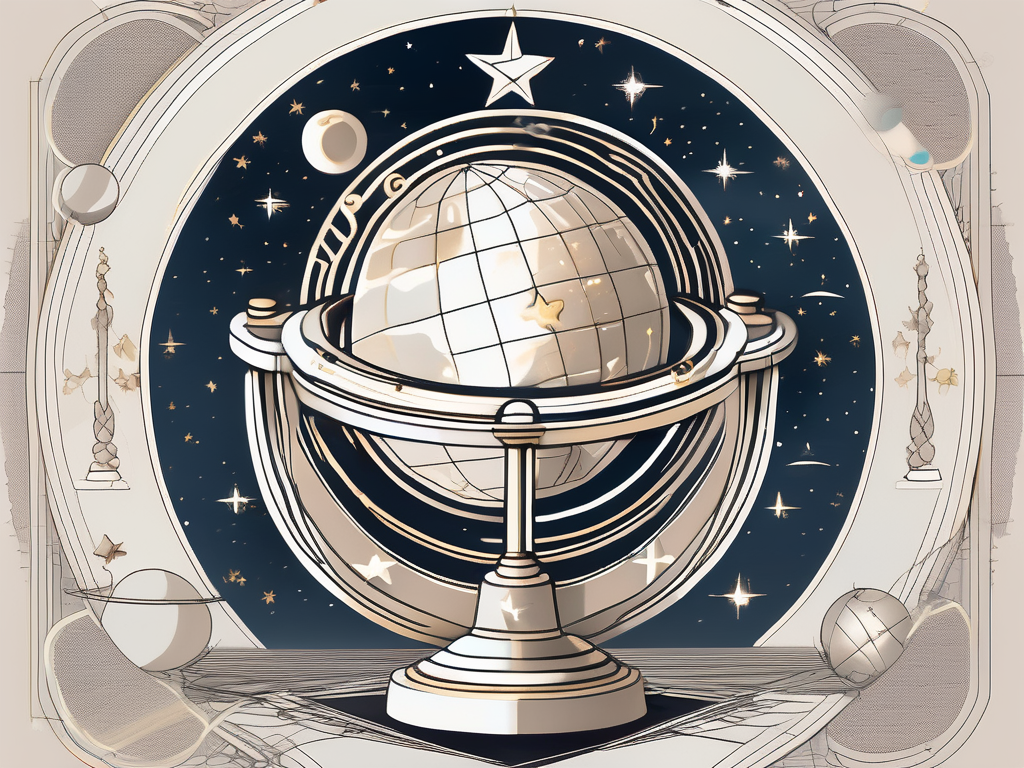In the vast pantheon of ancient Egyptian mythology, one fascinating aspect that continues to captivate our imagination is the concept of star deities. These celestial beings held immense significance in the religious beliefs and cultural practices of the Egyptians. By exploring the connection between astronomy and religion, deciphering the symbolism behind their iconography, and analyzing their influence on society, we can unravel the enigma surrounding these Egyptian gods.
Understanding the Concept of Star Deities in Ancient Egypt
Astronomy played a vital role in the religion of ancient Egypt. The Egyptians believed that the movements of celestial bodies were not mere natural phenomena but rather divine manifestations. They believed that the gods inhabited these luminous entities, granting them immense power and influencing every aspect of their lives.
Moreover, the stars were seen as the abodes of departed souls, guiding them through the afterlife. This intricate web of belief formed the foundation upon which the concept of star deities was built.
The Role of Astronomy in Ancient Egyptian Religion
Ancient Egyptians closely observed the night sky, noticing the cyclical patterns of stars, planets, and constellations. They relied on this knowledge to develop a sophisticated calendar system, essential for religious rituals and agricultural planning.
Additionally, the placement of celestial bodies informed the construction of temples and tombs, aligning them with specific stars or constellations believed to hold divine power. This sacred connection between the celestial and the terrestrial realms represented the harmonious relationship between the gods and humans.
The ancient Egyptians’ fascination with astronomy extended beyond practical applications. They believed that the celestial bodies were not only guides for their daily lives but also windows into the divine realm. By studying the stars, they sought to decipher the will of the gods and gain insight into the mysteries of the universe.
The Importance of Star Deities in Egyptian Mythology
Among the many gods in the Egyptian pantheon, there were several deities associated with stars. One such deity was Ra, the Sun God. Ra symbolized the sun’s life-giving energy and undertook a celestial journey every day, descending into the underworld at night and rising again in the morning.
Another prominent star deity was Nut, the Sky Goddess. She was often depicted as a woman arching over the world, her body adorned in stars. Nut’s role was to provide protection and shelter to both gods and humans, enveloping them in her starry mantle.
Further adding to the celestial symbolism, the god Osiris was closely linked with the constellation Orion. Osiris represented fertility, rebirth, and the afterlife. His association with Orion, which rises prominently in the sky during the Egyptian New Year, emphasized the cycle of life, death, and resurrection.
It is important to note that the concept of star deities was not limited to these three examples. Throughout ancient Egyptian mythology, various gods and goddesses were associated with specific stars or constellations, each embodying different aspects of the divine and influencing different areas of human life.
For instance, the goddess Isis was often linked with the star Sirius, which held great significance in Egyptian culture. Sirius’s annual rising, known as the “heliacal rising,” marked the beginning of the Nile flood, a crucial event for agricultural prosperity. Isis, as the goddess of fertility and motherhood, was believed to be responsible for the life-giving waters of the Nile.
Similarly, the god Thoth, associated with wisdom and writing, was connected to the star system known as the “Thoth’s Belt.” This constellation, consisting of three bright stars, was believed to represent the ibis, a bird associated with Thoth. The alignment of Thoth’s Belt in the night sky was seen as a celestial manifestation of the god’s presence and influence.
These examples illustrate the rich tapestry of star deities in ancient Egyptian mythology. The Egyptians’ deep understanding of the night sky allowed them to forge a profound connection between the celestial and the divine, shaping their religious beliefs and practices.
The Symbolism and Iconography of Egyptian Star Deities
The ancient Egyptians were a civilization deeply connected to the celestial realm. They utilized hieroglyphs, intricate artwork, and architectural marvels to convey their understanding of star deities and their significance in their religious beliefs.
Decoding the hieroglyphs used by the ancient Egyptians provides us with valuable insights into their perception of the stars. Stars were often represented as simple dots or asterisks, while constellations were depicted as distinctive shapes or figures. These hieroglyphs served as a medium for recording religious beliefs and myths, allowing us glimpses into the sacred world of the gods as envisioned by the ancient Egyptians.
Decoding Hieroglyphs: Stars in Ancient Egyptian Art
The intricate hieroglyphic script used by the ancient Egyptians was not only a form of communication but also a way to express their spiritual beliefs. The representation of stars in their artwork was significant, as it symbolized the connection between the earthly and celestial realms. By depicting stars as simple dots or asterisks, the ancient Egyptians conveyed the idea that these celestial bodies held immense power and were essential in their religious practices.
Furthermore, constellations were depicted as distinctive shapes or figures in the hieroglyphs. These representations allowed the ancient Egyptians to identify and understand the various constellations visible in the night sky. By decoding these hieroglyphs, we gain a deeper understanding of how the ancient Egyptians perceived the stars and their role in their religious cosmology.
The Sacred Geometry of Pyramids and Star Alignments
One of the most fascinating aspects of ancient Egyptian architecture is the alignment of pyramids with specific stars or constellations. The Egyptians believed in the profound connection between the earthly and celestial realms, and they sought to establish a direct line of communication with the gods through their monumental structures.
By aligning the pyramids with particular stars, the ancient Egyptians aimed to harness the power and guidance of these celestial bodies. The alignment of the pyramids with specific constellations showcased their deep-rooted belief in the influence of the stars on their daily lives and their quest for divine protection.
The sacred geometry employed in the construction of the pyramids further emphasized this connection. The precise measurements and alignments of these architectural marvels were not merely feats of engineering but deliberate attempts to create a harmonious relationship between the earthly and celestial realms. The pyramids served as physical representations of the ancient Egyptians’ devotion to the star deities, acting as conduits for their prayers and offerings.
In conclusion, the symbolism and iconography of Egyptian star deities are intricately woven into their hieroglyphs, artwork, and architectural achievements. Through the decoding of hieroglyphs and the study of the alignment of pyramids, we gain a deeper understanding of the ancient Egyptians’ profound connection to the celestial realm and their unwavering belief in the power and influence of star deities.
The Influence of Star Deities on Egyptian Society and Culture
The influence of star deities was not limited to the realm of myth and religion; it permeated all aspects of Egyptian society and culture.
Ancient Egyptians held a deep reverence for the celestial bodies that adorned their night sky. They believed that the stars were not mere twinkling lights, but powerful deities that held sway over their lives. These star deities were seen as guardians and guides, influencing everything from the annual flooding of the Nile to the reign of the pharaohs.
Star Deities in Egyptian Rituals and Festivals
The ancient Egyptians celebrated numerous religious rituals and festivals throughout the year. Many of these festivities revolved around the movements of celestial bodies, such as the annual flooding of the Nile, which was associated with the star Sirius. These rituals were conducted to seek the favor of the star deities and ensure the prosperity and well-being of the kingdom.
During these rituals, priests and priestesses would perform intricate ceremonies, invoking the power of the star deities. Elaborate processions would take place, with participants adorned in vibrant costumes and carrying sacred objects symbolizing the stars. The entire community would come together to honor and pay homage to these celestial beings, believing that their blessings would bring bountiful harvests, fertility, and protection from harm.
Furthermore, the Egyptians believed that the alignment of certain stars and constellations had a direct impact on human destiny. Astrologers and astronomers played a crucial role in deciphering the movements of the stars and interpreting their significance. Their knowledge was sought after by both the common people and the ruling elite, as it was believed that understanding the will of the star deities could provide guidance in all aspects of life.
The Impact of Star Deities on Pharaohs and Their Reign
The pharaohs, considered divine rulers, were believed to be direct descendants of the gods, including those associated with stars. As the intermediaries between the gods and the people, pharaohs sought to harness the power bestowed upon them by the star deities to maintain order, stability, and prosperity in their kingdom.
Pharaohs would often commission grand temples and monuments dedicated to the star deities, showcasing their devotion and seeking their favor. These structures were not only places of worship but also symbols of the pharaoh’s divine connection and authority. The alignment of these temples with specific stars and constellations was carefully planned, further emphasizing the importance of the celestial realm in the lives of the Egyptians.
Moreover, the pharaohs’ reigns were often marked by celestial events, such as the appearance of comets or the alignment of planets. These occurrences were seen as cosmic messages from the star deities, guiding the pharaoh in making important decisions and shaping the destiny of the kingdom. The pharaohs would consult their astrologers and astronomers, seeking their interpretations and advice, as they believed that the stars held the key to their success and the well-being of their people.
The influence of star deities on Egyptian society and culture cannot be overstated. From religious rituals and festivals to the reign of the pharaohs, the celestial realm played a central role in shaping the beliefs, practices, and aspirations of the ancient Egyptians. The stars were not just distant objects in the sky; they were divine beings that held the power to shape their destiny.
The Legacy of Egyptian Star Deities in Modern Astronomy
The impact of these ancient Egyptian beliefs and practices extends far beyond the sands of time. Even today, their legacy continues to resonate in the field of modern-day astronomy.
Ancient Egyptian Star Catalogues and Their Relevance Today
Egyptian astronomers meticulously recorded their observations of stars and celestial phenomena. These invaluable star catalogues provide us with crucial insights into the astronomical knowledge of the time and have contributed significantly to modern-day astronomical studies.
The Egyptian Roots of Modern Constellation Names
Many constellations recognized in modern astronomy have their origins in ancient Egypt. The famous constellation Orion, associated with the god Osiris, is a prime example. By tracing the etymology of constellation names, we can trace their lineage back to these ancient star deities.
The enigmatic star deities of ancient Egypt continue to intrigue and inspire us. Their celestial journey, symbolism, and profound impact on Egyptian society offer us a glimpse into the complex and fascinating world of these ancient gods. As we unveil the secrets of their existence, we uncover not only the mythology of the Egyptians but also the enduring bond between humanity and the wonders of the cosmos.












